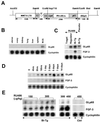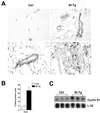Inducible expression of FGF-3 in mouse mammary gland
- PMID: 12169667
- PMCID: PMC123231
- DOI: 10.1073/pnas.172366199
Inducible expression of FGF-3 in mouse mammary gland
Abstract
Fibroblast growth factor-3 (FGF-3) is a crucial developmental regulator. Aberrant activation of this gene by mouse mammary tumor virus insertion results in pregnancy-responsive mammary tumorigenesis. To characterize better FGF-3 function in postnatal mammary gland development and cancer initiation/progression, we used a mifepristone (RU486)-inducible regulatory system to express conditionally FGF-3 in the mammary epithelium of transgenic mice. Ectopic overexpression of FGF-3 in pubescent mammary glands elicited severe perturbations in early mammary gland development leading to mammary hyperplasia. Ductal elongation was retarded, multiple cysts persisted in the virgin ducts, and ductal epithelium was expanded and multilayered. The altered ductal architecture and the persistence of hyperplastic multilayered epithelium reflect a defect in growth regulation, which resulted from an imbalance between mitogenic and apoptotic signals. By altering the duration of RU486 treatment, we showed that the persistence of mitogenic signal elicited by FGF-3 is crucial for the initiation, progression, and maintenance of the hyperplastic characteristic of the mammary epithelium. The manifestations elicited by FGF-3 could be reversed by RU486 withdrawal. In addition, synergism between the stimulus from estrogen and FGF-3 mitogenic pathways was evident and likely contributes to the pregnancy-dependent tumorigenesis of FGF-3. Taken together, the mifepristone-inducible regulatory system provides a powerful means for understanding the diverse roles of FGF-3 and its interactions with hormones in mammary gland tumorigenesis.
Figures







Similar articles
-
Wnt-10b directs hypermorphic development and transformation in mammary glands of male and female mice.Oncogene. 1997 Oct;15(18):2133-44. doi: 10.1038/sj.onc.1201593. Oncogene. 1997. PMID: 9393971
-
Hyperplasia and impaired involution in the mammary gland of transgenic mice expressing human FGF4.Oncogene. 2000 Dec 7;19(52):6007-14. doi: 10.1038/sj.onc.1204011. Oncogene. 2000. PMID: 11146552
-
A mouse mammary tumor virus-Wnt-1 transgene induces mammary gland hyperplasia and tumorigenesis in mice lacking estrogen receptor-alpha.Cancer Res. 1999 Apr 15;59(8):1869-76. Cancer Res. 1999. PMID: 10213494
-
Cripto: a novel epidermal growth factor (EGF)-related peptide in mammary gland development and neoplasia.Bioessays. 1999 Jan;21(1):61-70. doi: 10.1002/(SICI)1521-1878(199901)21:1<61::AID-BIES8>3.0.CO;2-H. Bioessays. 1999. PMID: 10070255 Review.
-
Control of the three-dimensional growth pattern of mammary epithelium: role of genes of the Wnt and erbB families studied using reconstituted epithelium.Biochem Soc Symp. 1998;63:21-34. Biochem Soc Symp. 1998. PMID: 9513708 Review.
Cited by
-
A crucial role for fibroblast growth factor signaling in embryonic mammary gland development.J Mammary Gland Biol Neoplasia. 2004 Apr;9(2):207-15. doi: 10.1023/B:JOMG.0000037163.56461.1e. J Mammary Gland Biol Neoplasia. 2004. PMID: 15300014 Review.
-
Multimodal integration using a machine learning approach facilitates risk stratification in HR+/HER2- breast cancer.Cell Rep Med. 2025 Feb 18;6(2):101924. doi: 10.1016/j.xcrm.2024.101924. Epub 2025 Jan 22. Cell Rep Med. 2025. PMID: 39848244 Free PMC article.
-
Genetic control of wayward pluripotent stem cells and their progeny after transplantation.Cell Stem Cell. 2009 Apr 3;4(4):289-300. doi: 10.1016/j.stem.2009.03.010. Cell Stem Cell. 2009. PMID: 19341619 Free PMC article.
-
Inducible expression of long-chain acyl-CoA hydrolase gene in cell cultures.Mol Cell Biochem. 2003 Oct;252(1-2):379-85. doi: 10.1023/a:1025510401226. Mol Cell Biochem. 2003. PMID: 14577613
-
Expression of autotaxin and lysophosphatidic acid receptors increases mammary tumorigenesis, invasion, and metastases.Cancer Cell. 2009 Jun 2;15(6):539-50. doi: 10.1016/j.ccr.2009.03.027. Cancer Cell. 2009. PMID: 19477432 Free PMC article.
References
-
- Humphreys R. C., Krajewska, M., Krnacik, S., Jaeger, R., Weiher, H., Krajewski, S., Reed, J. C. & Rosen, J. M. (1996) Development (Cambridge, U.K.) 122, 4013-4022. - PubMed
-
- Mansour S. L., Goddard, J. M. & Capecchi, M. R. (1993) Development (Cambridge, U.K.) 117, 13-28. - PubMed
-
- Wilkinson D. G., Bhatt, S. & McMahon, A. P. (1989) Development (Cambridge, U.K.) 105, 131-136. - PubMed
-
- Peters G., Brookes, S., Smith, R. & Dickson, C. (1983) Cell 33, 369-377. - PubMed
Publication types
MeSH terms
Substances
LinkOut - more resources
Full Text Sources
Other Literature Sources
Molecular Biology Databases

